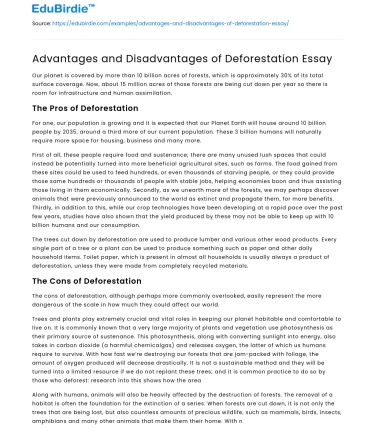Our planet is covered by more than 10 billion acres of forests, which is approximately 30% of its total surface coverage. Now, about 15 million acres of those forests are being cut down per year so there is room for infrastructure and human assimilation.
The Pros of Deforestation
For one, our population is growing and it is expected that our Planet Earth will house around 10 billion people by 2035, around a third more of our current population. These 3 billion humans will naturally require more space for housing, business and many more.
First of all, these people require food and sustenance; there are many unused lush spaces that could instead be potentially turned into more beneficial agricultural sites, such as farms. The food gained from these sites could be used to feed hundreds, or even thousands of starving people, or they could provide those same hundreds or thousands of people with stable jobs, helping economies boon and thus assisting those living in them economically. Secondly, as we unearth more of the forests, we may perhaps discover animals that were previously announced to the world as extinct and propagate them, for more benefits. Thirdly, in addition to this, while our crop technologies have been developing at a rapid pace over the past few years, studies have also shown that the yield produced by these may not be able to keep up with 10 billion humans and our consumption.
The trees cut down by deforestation are used to produce lumber and various other wood products. Every single part of a tree or a plant can be used to produce something such as paper and other daily household items. Toilet paper, which is present in almost all households is usually always a product of deforestation, unless they were made from completely recycled materials.
The Cons of Deforestation
The cons of deforestation, although perhaps more commonly overlooked, easily represent the more dangerous of the scale in how much they could affect our world.
Trees and plants play extremely crucial and vital roles in keeping our planet habitable and comfortable to live on. It is commonly known that a very large majority of plants and vegetation use photosynthesis as their primary source of sustenance. This photosynthesis, along with converting sunlight into energy, also takes in carbon dioxide (a harmful chemicalgas) and releases oxygen, the latter of which us humans require to survive. With how fast we’re destroying our forests that are jam-packed with foliage, the amount of oxygen produced will decrease drastically. It is not a sustainable method and they will be turned into a limited resource if we do not replant these trees; and it is common practice to do so by those who deforest: research into this shows how the area
Along with humans, animals will also be heavily affected by the destruction of forests. The removal of a habitat is often the foundation for the extinction of a series. When forests are cut down, it is not only the trees that are being lost, but also countless amounts of precious wildlife, such as mammals, birds, insects, amphibians and many other animals that make them their home. With nowhere else to go, they will be forced into areas that are not suitable for them. They spent thousands of years adapting to their surroundings, and they won’t be able to survive if they’re thrown into a new, unknown environment. As a matter of fact, there has been a drastic decline in the amount of wildlife that is present in certain areas that have suffered from deforestation more severely than others. In essence, we are removing a piece of ourselves when we no longer allow for animals to exist as they always have.
With all the excess carbon dioxide and greenhouse gases floating around un-recycled in the atmosphere, the effects of global warming have been becoming more and more visible. An example of this would be droughts: present in many countries with hotter climates already. Instead of having forests, which have their own natural watermoisture recycling system stably in place, we opt for agricultural activities, such as raising livestock and plants. These require much higher levels of water and moisture; a large majority of which is not recycled as with the forests are.
Many great medicines we have today had their foundations based off of those discovered in the forests, which only a small fraction of have been explored and documented by non-tribal humans.
A little known fact is that trees contribute greatly to flood prevention. They play a vital role by absorbing excess ground water and then dispersing it throughout the air through evaporation.






 Stuck on your essay?
Stuck on your essay?

